
| KIT: | CMR 1/72 Hughes 1B |
| KIT #: | 148 |
| PRICE: | Approximately $37 at http://hobbyshop.cz |
| DECALS: | One option each |
| REVIEWER: | Scott Van Aken |
| NOTES: | Two Resin Kits with Vacuformed Canopy |

| HISTORY |
The Hughes H-1 racer was developed to be the fastest landplane in the world, It was designed by Howard Hughes and Richard Palmer and built by Glenn Odekirk. On September 13, 1935, Hughes achieved the design goal by flying the H-i to a new world speed record of 352.322 mph. The record was set over a specially instrumented course near Santa Ana, California.
Since Hughes did not require a sponsor for the aircraft, the H-i had no markings except the license number NR258Y (later NX 258Y) in chrome yellow against the dark blue background of the wings, and in black against the doped aluminum rudder. The fuselage was left in its natural polished aluminum finish. The H-i was powered by a Pratt and Whitney Twin Wasp Junior radial piston engine, which was rated at 700 horsepower at 8,500 feet but which could deliver 1,000 horsepower for high-speed flight. A wind tunnel model of the aircraft was exhaustively tested in the 200-mph wind tunnel at the California Institute of Technology’s Guggenheim Aeronautical Laboratory. Actual performance figures for the aircraft closely matched the predicted design performance.
 The H-1 had two
sets of wings, The wings Hughes used to break the land plane speed record
were of a low aspect ratio and shorter than those with which it is now
fitted. The wings now fitted on the aircraft span 31 feet, 9 inches. have a
moderate-aspect ratio, and were used when Howard Hughes broke the
transcontinental speed record in the H-i on January 19, 1937. Hughes
departed Los Angeles before dawn and arrived at Newark Airport, outside New
York City, 7 hours, 28 minutes, and 25 seconds later. His average speed
over the 2,490-mile course was 332 mph, and this nonstop flight was truly
an outstanding accomplishment.
The H-1 had two
sets of wings, The wings Hughes used to break the land plane speed record
were of a low aspect ratio and shorter than those with which it is now
fitted. The wings now fitted on the aircraft span 31 feet, 9 inches. have a
moderate-aspect ratio, and were used when Howard Hughes broke the
transcontinental speed record in the H-i on January 19, 1937. Hughes
departed Los Angeles before dawn and arrived at Newark Airport, outside New
York City, 7 hours, 28 minutes, and 25 seconds later. His average speed
over the 2,490-mile course was 332 mph, and this nonstop flight was truly
an outstanding accomplishment.
The Hughes H-1 was designed for record-setting purposes, but it also had an impact on the design of high-performance aircraft for years to come. Some of the outstanding design features of the H-1 were: a close fitting bell-shaped engine cowling to reduce airframe drag and improve engine cooling; gently curving wing fillets between the wing and the fuselage to help stabilize the airflow, reduce drag, and prevent potentially dangerous eddying and tail buffeting; retractable landing gear to reduce drag and increase speed and range (typical of everything for the H-1, the landing gear was so perfectly fitted that the gear fairings and doors are difficult to see without looking closely); all rivets and joints flush with the aircraft’s skin and flathead and counter-sunk screws on the plywood wings; ailerons designed to droop 15 degrees when this flaps are fully extended to improve lift along the full length of the wing during landing and takeoff; the pilot sitting in a smoothly faired and totally enclosed cockpit, which had an adjustable canopy windscreen to permit easy entry and exit from the aircraft.
The Hughes H-1 racer was a major milestone aircraft on the road to such radial engine-powered World War II fighters as the American Grumman F6F Hellcat and Republic P-47 Thunderbolt, the Japanese Mitsubishi Type 0 (Zero), and the German Focke-WuIf FW 190. It demonstrated that properly designed radial-engine aircraft could compete with the lower-drag inline designs despite having larger frontal areas because of their radial engine installations.
The H-1 was kept in the Hughes factory at Culver City, California, until it was donated to the Smithsonian Institution in 1975. It is now exhibited in the Golden Age of Flight gallery of the National Air and Space Museum.
| THE KIT |
 This
is the first CMR kit I've seen and like many Czech resin kits, it is very nicely
done. There is no box, but the kit parts are in compartmentalized clear bags
that are pretty thick. These are then inside another rather thick clear bag and
on the back and front of the kit parts are a card showing the aircraft in
questions and several pages of instructions. Makes for good protection as I only
found that one part had departed the resin pour stub during shipment.
This
is the first CMR kit I've seen and like many Czech resin kits, it is very nicely
done. There is no box, but the kit parts are in compartmentalized clear bags
that are pretty thick. These are then inside another rather thick clear bag and
on the back and front of the kit parts are a card showing the aircraft in
questions and several pages of instructions. Makes for good protection as I only
found that one part had departed the resin pour stub during shipment.
What makes this a real bargain is that you get two complete kits in this set. It includes the short wing 1935 aircraft and the longer winged 1937 plane that now sits in the Smithsonian Institution's Air and Space Museum. Since the Hughes 1B was designed for one thing and that was to go fast, you won't find a lot of fiddly bits on these kits. What you will find is a nicely molded engine on which a rather complex exhaust and intake system is attached for you have to put on each individual intake and exhaust stack. A seemingly daunting task in 1/72, but the instructions are equally complete as to what goes where.
The engine is the same in both kits. When we get to differences, there are A and B parts. The biggest difference being the wings and tail planes and fuselage. The flying surfaces are single piece and are designed in such a way as to provide a good fit. Cockpits are identical and as basic as you can get with seat, rear bulkhead, control stick, instrument panel and floor. The other differences are in the landing gear with the later IB having more robust retraction struts. There are four complete vacuformed transparencies for those of us who may need that second (or third) one. It is, of course, two per kit. No photo etch in this one.
 Instructions
are superlative in every way. The drawings are large and superbly done. Any
color information required during construction is provided. The painting and
marking guides are equally well done with five view drawings for each aircraft
and whatever color info needed provided. A real bonus are four pages of crisp
and clear black and white photos of the aircraft at the Smithsonian. There are
lots of close-up0s of the engine and undercarriage, and wheel wells and cockpit
from many angles. Frankly all you could get from a book on the subject. Decals
are provided for both aircraft; the long wing version's registration sans
the N.
Instructions
are superlative in every way. The drawings are large and superbly done. Any
color information required during construction is provided. The painting and
marking guides are equally well done with five view drawings for each aircraft
and whatever color info needed provided. A real bonus are four pages of crisp
and clear black and white photos of the aircraft at the Smithsonian. There are
lots of close-up0s of the engine and undercarriage, and wheel wells and cockpit
from many angles. Frankly all you could get from a book on the subject. Decals
are provided for both aircraft; the long wing version's registration sans
the N.
| CONCLUSIONS |
This is one of the neatest ideas I've seen for a kit as it allows you to do both variants of a famous aircraft. It doesn't hurt that the moldings are well done and that the aircraft is not complex. The only area one will have to take one's time is assembling the engine, and that is due to all the intake and exhaust pipes. A magnifier would be recommended for this. Overall, a great set and one that should produce a quality model when done.
August 2006 My Thanks to
http://hobbyshop.cz for the review samples.
Get yours on-line at the link to the left. If you would like your product reviewed fairly and quickly by a
site that has nearly 325,000 visitors a month, please
contact
me or see other details in the
Note to
Contributors.